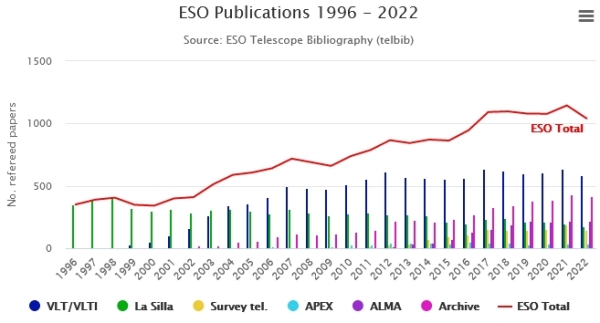In 2022, the ESO community once again published more than 1,000 papers, for the 6th consecutive year. The total number of data papers included in the ESO Telescope Bibliography (telbib) published between 1996 and 2022 has risen to over 19,500. Despite the fact that ESO's facilities were not operating at the beginning of the pandemic, and then were operating with reduced capacity for several months, the number of refereed data papers remained remarkably stable.
ESO Data Papers Published in 2022

VLT / VLTI data led to more than 580 refereed papers in 2022. With more than 160 data papers published in 2022, MUSE has been the most productive VLT instrument during the past three years.
ESO’s survey telescopes, VISTA and the VST, provided data for almost 150 refereed papers in 2022. About two thirds of these papers used VISTA observations, one third VST data, and a fraction of approximately 17% deployed data from both telescopes. The VST became a hosted telescope in October 2022.
Observations obtained at ESO’s La Silla facilities led to approximately 175 papers. Very likely, several factors played a role in the slightly lower output compared to previous years, including the unavailability of the site during the pandemic, along with an increasing number of hosted or national telescopes (for instance the Max-Planck-Gesellschaft/ESO 2.2-metre telescope, the Swiss 1.2-metre Leonhard Euler Telescope, and the Danish 1.54-metre telescope), which are hosted, but not run by ESO, and whose data papers are therefore not included in the ESO statistics.
The number of papers that use exclusively archival data, i.e., observations without any overlap between the authors and the team of proposers, has increased continuously during recent years, reaching almost 40% in 2022. About a quarter of all data papers (24%) deployed only archival observational data, without any ESO observations obtained by the authors; these papers would not have been in telbib without the existence of the ESO Science Archive.
APEX, a collaboration between the Max Planck Institute for Radio Astronomy, the Onsala Space Observatory, and ESO, provided data for almost the same number of papers as in the previous year, bringing the number of data papers from all APEX partners to over 930. A major fraction of the papers published in 2022 used observations obtained partly or exclusively during ESO observing time (63%). A new ESO-operated APEX instrument, CONCERTO, saw first light in April 2022, but it will take some time before the first data papers are published.
The ALMA user community published almost 450 data papers in 2022, using observations from all ALMA partners. Once again, approximately half of them (49%) made use of at least some data obtained during ESO ALMA time. The ALMA bibliography is maintained jointly by the librarians at ESO and the National Radio Astronomy Observatory in the USA as well as by the National Astronomical Observatory of Japan. Publications based on data from all ALMA partners are recorded in telbib, but only those based on ESO observing time are counted in the ESO statistics, unless otherwise noted.
The statistics presented here are derived from telbib, a database of refereed papers published by the ESO users community since 1996. Telbib links publications with the data in the ESO Science Archive and assists the ESO management with evaluating the organisation’s productivity and impact. Telbib is curated and developed by the ESO Library and Information Centre. Whilst text-mining scripts are applied when screening the literature for ESO data papers, articles are carefully examined by the curators before they are added to the database to ensure that all telbib papers use partly or exclusively data from ESO facilities for which observing time was recommended by ESO. The public telbib interface provides visualisations of search results including on-the-fly graphs and predefined charts.
Details about telbib, including information about the methodology used to screen and classify papers, can be found on the web. A wide range of statistics, updated weekly, are provided. Records of all 2022 data papers written by the ESO user community can be accessed. A separate listing of refereed publications by ESO scientists with or without use of ESO data is available.
